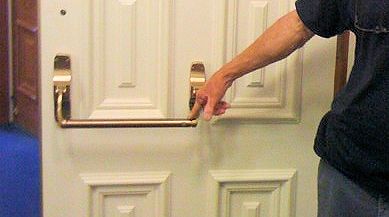Late last Friday night I selected 5 gift card winners at random from those who sent in photos last week to celebrate the 5th birthday of iDigHardware, and this week I will post photos from one of the winners each day. I haven’t notified the winners yet, so it will be a surprise!
Bob Larson of Builders Hardware and Supply took this photo on a visit to the Nevada State Capitol Building.
I can hear some of you saying (in a Peewee Herman voice), “What’s the significance?!” Panic hardware* is required when you have a lock or latch on an Assembly or Educational occupancy with an occupant load of >50 (2006 International Building Code and later) or >100 (NFPA 101, and IBC prior to 2006).** As you can see from the helpful signage, the door in this photo serves an Assembly occupancy. 🙂
When panic hardware is installed, it must be mounted between 34 inches and 48 inches above the floor. It must operate with a maximum of 15 pounds of force to release the latch.*** And the actuating portion of the panic hardware must
“extend at least one-half of the door leaf width.”
I have been taught since my first days in hardware school, that this means the width of the touchpad or crossbar has to measure at least half the width of the door. If you order a Von Duprin 99 series touchpad device for a 3-foot wide door, the touchpad measures 18 inches. On a device for a 4-foot wide door, the touchpad measures 24 inches. If you have a door that is larger than 3 feet wide, even if it only a few inches over 3 feet, technically you would need to order a device for a 4-foot wide door and cut it down (this varies by manufacturer and model).
I’ve had a couple of situations lately, where someone interpreted the “actuating portion” requirement in a different way – saying that the touchpad just needs to make it to the half-way point of the door width. Since the touchpad typically starts a few inches in from the door edge, a touchpad extending to the middle of the door would not measure half the width of the door – it would measure a few inches less.
I don’t think this interpretation is correct, although an AHJ may allow it in certain circumstances. In one case, the doors were 3 feet, 2 inches wide, and 3-foot devices had been installed. Technically the touchpads were an inch too short. I’m not going to lose sleep over that, but my job is to make sure you’re educated on the codes. If you supplied 3-foot devices for 3-foot, 2-inch doors and the AHJ interpreted the requirement as I do, you may end up replacing the devices.
So back to the photo. A crossbar device typically spans most of the door width. This is a total guess, but maybe these doors are a little wider than 3 feet, and devices were ordered for 3-foot doors. In that case, the hardware would interfere with the panel or trim on the door. So maybe the device was cut down to avoid that conflict. My previous theory of “why” was proven unlikely (this device is shipped with a 42-inch crossbar), so I’ll try another guess. There was a time when measurement of clear width was not well-defined in the codes, so there were some inventive methods of measuring clear width. Some of the fire marshals in my area required panic hardware to be cut short to increase the clear opening width with the door opened past 90 degrees. Luckily this is defined in the codes now, so no need for shorty panics. At first glance you might think that the panics are too short – that the crossbars don’t extend half the width of the door. But I took some rough measurements from the photos, and I think they just make it.
* Panic hardware is used on non-fire-rated doors, and is tested per UL 305 – Panic Hardware. Fire exit hardware is panic hardware that is used on fire doors, and it is tested per UL 305 and also UL 10B, UL 10C, or NFPA 252 – all fire door assembly test methods. There is more information about panic hardware vs. fire exit hardware here.
** There are additional requirements for High Hazard occupancies and electrical rooms, and some state codes may differ. There is also an exception for keyed locks on the main entrance of certain occupancies, which may affect the requirements for panic hardware on those doors. There is more information here about panic hardware on electrical rooms, the exception for key-operated locks, and panic hardware in general.
*** An editorial change was made in the 2010 ADA Standards which requires door hardware to operate with 5 pounds of force. This requirement has also been incorporated into the 2013 California Building Code. This creates a conflict with panic hardware that is currently on the market, which does not operate with 5 pounds of force. There is more information about this change here.
Congrats to Bob, and thank you to Jim Bystry of Allegion for forwarding the photos!
You need to login or register to bookmark/favorite this content.







I don’t know, but I would be embarrassed if this was my job. Why didn’t they order 48″ bars and cut them down? Maybe they were in a hurry and couldn’t wait for the correct bars. Or am I missing something?
You’re not missing anything, or if you are, I’m missing it too! Any theories?
Don’t most cross bar type devices come standard with a 4 foot bar?
You just shot down my theory…this device ships with a 42″ bar. Why do you think they did this?
Let’s see…they lost one of the bars so the remaining bar was cut in half and installed on the doors?
Typical construction site and hardware installer.
They either lost one of the bars or ran over it with some piece of equipment, and instead of ordering another push bar, they took the remaining one and cut it in half.
Used 1 piece per assembly!
I cannot fathom any other reason for installing such a short bar.
Most likely the reason for this odd installation was the paneling and the spec/ordered length of the 88 cross bar meant the hinge portion was going to land directly on the moulding. So, instead of crying “whoopsie” and ordering a longer cross bar to cut to a custom length allowing it to fit beyond the last vertical panel trim… (Well, 3 muted descending trumpet notes)
Nice to know it barely meets code because that vindicates the mouth breather who installed these classic Von Duprin exit devices.
The short bar brings back a memory. When I first was hired by a hospital, I began to survey the fire rated doors for proper installation and freedom from defects. The first thing I noticed was these 1979 doors had actuating hardware for a 48 inch door but the hardware was about 4 inches short for each leaf of the cross corridor fire doors, pretty obvious the first time I looked at one. This was because the doors were about 53 to 54 inches wide each and custom made.
When the hospital was designed, the designer was given a challenge to design a recessed fire door that would nest in pockets in the wall on either side of the 8′ wide required corridor width. This effectively recessed the operating bar almost flush with the wall so they were not knocked apart by people moving carts, etc. This was good for reliability but bad for code compliance. At that time, there were no standard fire rated doors of that width because testing stopped at 48″. The code at that time restricted the rated doors to 48″ width. Fifty two pair of oversized, unlabeled cross corridor doors required fire labeling but none were labeled. The doors were constructed very substantially. So, we were allowed to do a 100 percent coverage of fire sprinklers in the building and with that were able to have the State do a Fire Safety Equivalency Survey that allowed us to safely leave the doors operational until they could be replaced in a reasonable time frame as areas were remodeled. In this case the actuating bar width tipped off a different problem. Once we had the building protected by sprinklers, other defects were taken off the table as well so it was well worth the money we spent.
I love your comments, Gerry!
Twisted interpretation of hardware clearance minimums for ADA??
Effort to make the doors look bigger from that chair behind the bench on the far side by making the exits look smaller?
And the best theory…. Wait for it…..
There was only ONE bar shipped with the two devices so they used half for each door…..
Actually, your comment gave me another idea…I updated the blog post with a new theory.
The question is or was that the hardware is to latch.. I am wondering if this door latches as there are not rods or latch to be seen on either doors. Are these devices just to pull the doors shut as it looks like there are pulls on the out side of the door due to the one through bolt screw on top of the hardware. There are marks under the sign and that could be from small spring balls to hold door in place. I don’t think there are inner rods as the pull plates on the outside are TDC of the handle. Interesting picx for sure and Its fun to see all the difference in answers from everyone.
I can’t be absolutely sure from the photos, but I assumed that they were concealed vertical rod panics.
Are those 88 series devices and are those doors made of wood? If so I don’t think the 88 series is available for concealed vertical rod on wood doors. I think we are looking at dummy devices with roller latches, or something, at the top.
Yes I tried to see that but the CVR would be in the same line as the though bolt and there are no screws or bolts on the top as I can see. I was wondering if the 88 series should be used due to the new codes talking about the safety
Its the door panels that are governing what’s happening. The panel spacing doesn allow for a standard 3′ or the 42″. So in a what do I do here moment the installer came up with this solution. The installer doesn’t always know what the code requires (they should but often don’t. The architect and specifer should know and should have come up with a different solution. But after the units where installed the problem is “what do we do now?” Put it on the punch list and see how long it gets ignored?
Ok I think this is a trick question as the screw head on the top of the 88 series is from the pull handle on the outside and there are no closer there. This is not a fire door as there are no signs of the Vertical rod upper and vertical rod is not there on the frame and this door is pull to close but there is no lock or latches.
I don’t know why anyone would go to the expense of 88 devices if the doors didn’t need to lock or latch, but I guess anything’s possible!
For a double leaf door unequal (36″-27”)wide , do the 5547WDC-F) can be installed or the 27” is too short to cut the bar?
The picture above did not show if the cross bar is for fire exit or panic exit.
Hi Nabil – A 55 device can be cut down for a 27-inch door – no problem.
– Lori